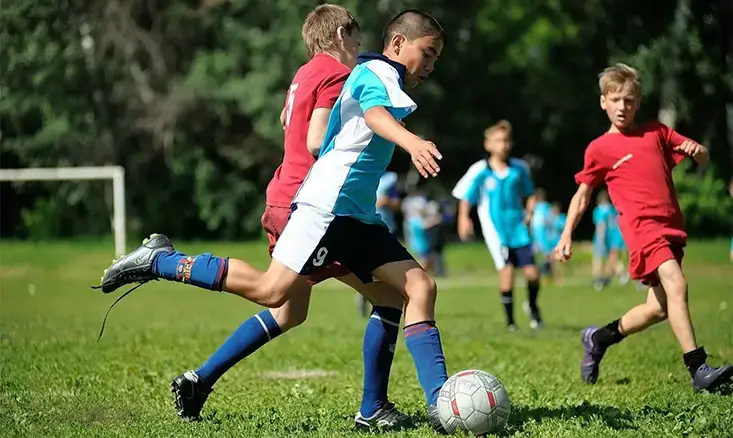The Youth Soccer 4-3-3 Formation

CRFC BLOGS
LATEST BLOGS & NEWSLETTERS
The Youth Soccer 4-3-3 Formation
The 4-3-3 formation is one of soccer’s most popular and versatile setups. It consists of four defenders, three midfielders, and three forwards. This formation has been widely adopted in professional and youth soccer due to its balance between attack and defense. It promotes teamwork, spatial awareness, and gameplay.
Importance of 4-3-3 Soccer Formation
The popularity of the 4-3-3 formation has grown over the years because it allows teams to dominate the midfield while providing multiple attacking options. This formation is especially beneficial for youth teams, as it helps young players understand different roles and responsibilities on the field. The 4-3-3 encourages an engaging and effective style of play, making it a favorite among coaches and players alike.
4-3-3 Soccer Formation Positions and Numbers
Detailed Positioning
In the 4-3-3 formation, each player has a specific role and number:
1: Goalkeeper
2 and 3: Full-backs
4 and 5: Center-backs
6: Defensive midfielder
8 and 10: Advanced midfielders
7 and 11: Wingers
9: Central striker
Specific Roles
Each position has unique responsibilities that contribute to the team’s overall effectiveness. For example, the goalkeeper’s main task is to prevent goals, while the wingers focus on creating and scoring goals. Understanding these roles helps players perform their duties effectively and ensures the team operates as a cohesive unit.
The goalkeeper is the last line of defense and is crucial for preventing the opposition from scoring. Full-backs provide width in attack and defense, while center-backs focus on protecting the goal. The defensive midfielder shields the defense and breaks up opposition play. The advanced midfielders drive the team forward, creating opportunities for the attackers. Wingers stretch the defense and create chances, and the central striker is the focal point of the attack, aiming to score goals.

4-3-3 Soccer Formation Structure
Defensive Setup
In the 4-3-3 formation, the defense consists of four players: two center-backs and two full-backs. The center-backs (usually wearing numbers 4 and 5) protect the central area in front of the goalkeeper. They must be strong, good at tackling, and effective in the air. Their primary job is to stop the opposition’s attackers from getting close to the goal and to clear any dangerous balls from the penalty area.
The full-backs (numbers 2 and 3) play on the left and right sides of the defense. They need to be quick and capable of supporting both defense and attack. Their roles include blocking opposition wingers, making overlapping runs, and providing width in attack. Full-backs are often required to cover a lot of ground, as they need to be involved in both defensive duties and attacking plays.
Midfield Configuration
The midfield in a 4-3-3 formation typically includes three players: one defensive midfielder (often wearing number 6) and two more advanced midfielders (8 and 10). The defensive midfielder protects the defense, intercepts passes, and breaks up opposition attacks. They are the team’s anchor, providing stability and linking the defense with the attack.
The two advanced midfielders must be versatile and capable of supporting defense and attack. They should have good passing skills, vision, and the ability to make forward runs to support the forwards. These midfielders often act as the team’s engine, driving play forward and helping maintain possession. They are also responsible for creating scoring opportunities and tracking back to defend when necessary.
Attacking Trio
The attacking trio usually includes one central striker (9) and two wingers (7 and 11). The team’s primary goal-scorer is the central striker, responsible for finishing off attacks and holding up the ball to bring others into play. They must be strong, quick, and positioned well to get into scoring areas.
The wingers play on the left and right sides of the attack. They need to be fast, skilled at dribbling, and capable of delivering accurate crosses. Their role is to stretch the opposition’s defense and create scoring opportunities. Wingers are often the players who can change the game with their speed and creativity, providing the team with a constant attacking threat.
Tactical Explanation
Formation Tactics Explained
The 4-3-3 formation is designed to control the midfield and provide multiple attacking options. It’s a flexible setup that can adapt to different situations during a game. Players must understand their roles and maintain good spatial awareness to exploit the formation’s strengths.
This formation encourages a possession-based style of play, where keeping the ball and controlling the game’s tempo is vital. The midfield trio maintains possession and links the defense with the attack. The formation also allows for quick transitions from defense to attack, with the wingers providing width and the central striker acting as the primary target for passes.
Attacking Strategy
The primary attacking strategy in a 4-3-3 formation is to use the width provided by the wingers. This stretches the opposition’s defense, creating space for the central striker and advancing midfielders. The “false 9” is a variation where the central striker drops more profoundly into the midfield, creating confusion for the opposition and allowing wingers to cut inside and exploit the space.
Wingers in a 4-3-3 formation are crucial for creating goal-scoring opportunities. They can take on defenders, deliver crosses, and cut inside to take shots on goal. The advanced midfielders support the attack by making forward runs and providing through balls for the wingers and strikers. This multi-faceted approach makes the 4-3-3 a potent attacking formation.
Defensive Strategy
Defensively, the 4-3-3 formation aims to maintain solidity with the back four while using the midfield to disrupt the opposition’s play. The full-backs and defensive midfielder are crucial in intercepting passes and marking opposition players.
The defensive midfielder acts as a shield in front of the defense, breaking up attacks and intercepting passes. The full-backs are responsible for stopping opposition wingers and preventing crosses into the box. The center-backs must remain solid and organized, communicating with each other and the goalkeeper to maintain a strong defensive line.

Strengths of the 4-3-3 Formation
Offensive Capabilities
The 4-3-3 formation is highly effective in attack due to its flexibility and width. It encourages dynamic, attacking play and allows for quick transitions from defense to offense. Using wingers gives the team natural width, stretching the opposition’s defense and creating space for the central striker and midfielders to exploit.
Midfield Control
With three midfielders, teams can dominate possession and control the game’s tempo. This setup allows for effective ball distribution and support in attack and defense. The midfield trio can outnumber the opposition in central areas, making it easier to maintain possession and create scoring opportunities.
Defensive Solidity
The balanced defensive structure of the 4-3-3 formation ensures that the team remains solid at the back. The midfielders’ ability to support the defense further strengthens the team’s defensive capabilities. The formation’s flexibility allows players to adapt to different situations, providing a solid defensive base while offering attacking options.
Weaknesses of the 4-3-3 Formation
Vulnerabilities
One of the main weaknesses of the 4-3-3 formation is its susceptibility to counterattacks. The defense can be exposed if the midfielders and fullbacks are caught out of position. Teams that are quick and efficient in transition can exploit this vulnerability.
Players must maintain good positional discipline and communicate effectively to mitigate this risk. The defensive midfielder is crucial in breaking up counter-attacks and protecting the back four. Full-backs must be aware of their defensive responsibilities and avoid getting caught too high up the field.
Physical and Tactical Demands
The formation requires high levels of fitness and tactical discipline. Players, especially the full-backs and midfielders, must cover much ground and maintain their positions throughout the game. This can be challenging, particularly for younger or less experienced players.
Coaches must ensure that players understand their roles and responsibilities within the formation. Regular training sessions focused on fitness and tactical awareness can help players meet the physical and mental demands of the 4-3-3 formation.
Comparison with Other Formations-4-4-2 vs. 4-3-3
The 4-4-2 formation is more rigid and defensively solid, but it lacks the attacking flexibility of the 4-3-3. The 4-3-3 formation offers more width and attacking options, making it more suitable for teams that want to play an offensive game.
The 4-4-2 formation provides a solid defensive base and is more accessible for players to understand. However, it can be less effective in controlling the midfield and creating scoring opportunities. The 4-3-3 formation, with its three midfielders, offers better control of the central areas and more dynamic attacking play.

Implementation in Youth Soccer
Suitability for Youth Teams
The 4-3-3 formation is well-suited for youth teams as it promotes teamwork, spatial awareness, and versatile play. It helps young players better understand different roles and responsibilities on the field. The formation’s flexibility allows coaches to adapt their tactics to suit the strengths and weaknesses of their players.
Coaching Tips
Coaches should focus on teaching players their specific roles within the formation. Drills and exercises that emphasize positional understanding and tactical awareness are crucial. Encouraging communication and teamwork is also vital for success.
Training sessions should include exercises that simulate game situations, allowing players to practice their roles within the 4-3-3 formation. Coaches should provide feedback and guidance to help players understand their responsibilities and improve their performance.

Conclusion
Understanding and adapting to the 4-3-3 formation can significantly enhance a team’s performance. It promotes a versatile and engaging style of play, making it a favorite among coaches and players alike. By focusing on positional discipline, teamwork, and tactical awareness, teams can maximize the benefits of the 4-3-3 formation and achieve success on the field.
Join our Upcoming Seasons and Camps to learn and practice youth soccer formations.
FAQs
What are the key strengths of the 4-3-3 formation?
The 4-3-3 formation is known for its flexibility and dynamic attacking options. It allows teams to control the midfield with three central players while providing width through the two wingers. The formation promotes a high-pressing style of play, which can disrupt the opposition’s build-up and create scoring opportunities. Additionally, it supports quick transitions from defense to attack, making it practical for counter-attacking.
What are the main weaknesses of the 4-3-3 formation?
One of the primary weaknesses of the 4-3-3 formation is its vulnerability to counter-attacks, especially if the full-backs are caught out of position. This formation requires high fitness levels and tactical discipline from all players, particularly the midfielders and full-backs, who must cover much ground. If the team is well-coordinated, it can resist overloads in the broad areas and central midfield, leading to defensive gaps.
How does the 4-3-3 formation compare to the 3-4-3 formation?
The 4-3-3 formation focuses on a balanced approach with four defenders, three midfielders, and three forwards, offering both defensive solidity and attacking width. In contrast, the 3-4-3 formation employs three central defenders and four midfielders, which can provide more midfield dominance and additional attacking options. However, the 3-4-3 can be more vulnerable defensively if the wing-backs fail to track back. The choice between the two depends on the team’s tactical priorities and the players’ strengths.
What teams typically use the 4-3-3 formation?
Many top-level teams use the 4-3-3 formation, including Barcelona, Real Madrid, Liverpool, and Manchester City. These teams favor the formation’s ability to dominate possession, press high up the field, and create numerous attacking opportunities. The 4-3-3 formation’s versatility and balance make it popular among coaches prioritizing solid defense and dynamic attacking play.
Is the 4-3-3 formation suitable for youth soccer?
Yes, the 4-3-3 formation is suitable for youth soccer. It helps young players develop essential skills such as teamwork, spatial awareness, and positional discipline. The formation’s structure allows coaches to teach various aspects of the game, including defensive organization, midfield control, and attacking movements. By understanding their specific roles within the 4-3-3, young players can understand the game comprehensively, which benefits their overall development.

Did you find this useful?


